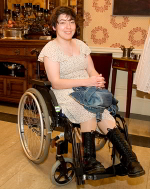This year’s CIEP conference was held online, from 2 to 4 November. Attendees from all over the world logged on to learn and socialise with their fellow editors and proofreaders, and a number of delegates kindly volunteered to write up the sessions for us. Miranda K Lloyd reviewed Conscious language: making editorial decisions for inclusion, presented by Sarah Grey.
As a proofreader and editor with a disability, I was excited to attend Sarah Grey’s session, Conscious Language: Making Editorial Decisions for Inclusion.
I already knew a bit about the importance of person-first language and inclusivity in publishing, and I was excited to learn more from an expert.
What did I learn? And what can we do to be more inclusive?
Inclusivity is more than person-first language
In fact, there is some lively debate about whether person-first language helps promote equality.
Words shape our perception of the world, how we see ourselves and how we feel. Editing for conscious language emphasises kindness, empathy, justice, respect, inclusion and accuracy. The way language is used has a huge influence over people and events, especially in politics and public forums.
As editors, we have great power over, and responsibility for, how language is shaped and used.
Consider the last speech you heard on the news. How did it make you feel? How might it be perceived by others? What will the consequences of a piece of writing be? Will it do any harm?
Language is changing faster than ever before
Be aware of these changes and check how a word or phrase is used. I was shocked to find that a common UK word is considered a grievous slur in parts of North America, and many people were deeply hurt when it was recently used in a popular TV series.
Ask the right questions
Who is the author? Who is the audience? Who is mentioned in the text? Is their perspective included? Does the author’s perception of their audience match the audience’s perception of themselves?
Will the audience appreciate a cultural reference or turn of phrase? Will it add to their experience or alienate them? Is an author forgetting a section of their readership? And if so, what can we do to include them?
Be aware of your own lack of knowledge
Ask yourself: ‘Am I the right editor for this job? Do I have the experience and background to appreciate the cultural context, sensitivities, dialect and other characteristics around this text?’
Listen, read and seek out diverse perspectives. Follow different communities and debates on social media – Twitter is great for this – and consider consulting a sensitivity reader.
Check your (and your author’s) sources
If your author is using sensitive or outdated terms, is the reader made aware of this? If you’re working on an academic text, are the citations consistent? Alert your client if they’re citing female authors by first name and male authors by last name.
Academics’ reputations live or die by how often their work is cited. Citing works by authors from underrepresented backgrounds makes their work visible and draws them into the mainstream.
And finally …
If your client ignores your advice on inclusive language, credits you and publishes anyway, you can say, ‘I gave some advice that was not taken’ and move forward, confident you did your job.
Follow Sarah @GreyEditing on Twitter.
 Miranda K Lloyd began working as a freelance proofreader and editor in December 2019. She has a disability and is committed to championing inclusivity in publishing, and making equality and diversity central to her business. Miranda is an Intermediate Member of the CIEP. She is currently taking on work and welcomes all enquiries. Contact her @mirandaklloyd on Twitter.
Miranda K Lloyd began working as a freelance proofreader and editor in December 2019. She has a disability and is committed to championing inclusivity in publishing, and making equality and diversity central to her business. Miranda is an Intermediate Member of the CIEP. She is currently taking on work and welcomes all enquiries. Contact her @mirandaklloyd on Twitter.
Posted by Abi Saffrey, CIEP blog coordinator.
The views expressed here do not necessarily reflect those of the CIEP.

